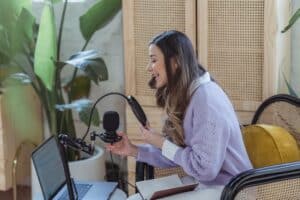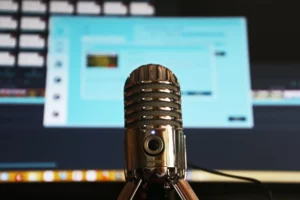Castos is a participant in the Amazon Services LLC Associates Program. We may earn commissions from your purchases on Amazon.com, though at no cost to you.
Two-person interview podcasts are the most popular format (one host, one guest), but they aren’t the only kind. Lots of shows do well with three and even four participants.
Running a 4-person podcast isn’t much different than producing a typical show, but there are some unique needs and challenges. Let’s talk about why group podcasting can be right for your show, what equipment you need, and how to be successful.
Why Podcast as a Group?
Podcasting as a group is attractive because it takes a lot of pressure off of one person. No single person is responsible for 30-minutes or an hour of conversation. If one person can’t find something to say, someone else probably can.
Combining four brains is also helpful when it comes to brainstorming content. Four people make it simpler to generate ideas, make interesting points, and engage with your community.
A large group makes promoting your podcast easier as well. Some multi-person shows like to delegate marketing activities to each member. One person handles the blog, another manages the newsletter, a third posts on social media, etc.
The major downside to group podcasting, however, is two-fold. First, you have to split any revenue generated from your show amongst the whole group. Second, it’s hard to build a personal brand when you share time with three other people.
Equipment for a 4-Person Podcast Setup
The equipment for a 4-person podcast setup isn’t much different than a typically solo or two-person show, with a few caveats. Here’s what you need:
Podcast microphones
Obviously you need microphones for your 4-person podcast setup. A good mic means better audio quality. It’s important that everyone has their own mic. (No sharing!)
Before you pick out mics, decide if you want USB or XLR mics. XLR mics sound better, but they plug into a mixer or interface, not your computer. USB mics plug directly into your computer, which makes them easier to use, but they don’t sound as great (not that they sound bad).
For a more in-depth look at the difference between these two types, check out our guide on XLR vs USB podcast microphones. When you’re ready to pick out a mic, see our picks of the best podcasting microphones. Here are our favorites:
- Audio-Technica ATR2100 USB/XLR Microphone
- Samson Q2 USB/XLR Dynamic Microphone
- Shure SM7B Vocal Dynamic XLR Microphone
Pro tip: Each microphone should have a pop filter to dampen those plosive sounds. These are cheap and great ways to make your recording more pleasant.
Headphones
Headphones aren’t essential, but they can elevate the quality of your audio by giving you a real-time understanding of your own voice. Headphones are inexpensive, so everyone should have them, even if you just use that cheap pair that came with your phone.
Find a good pair in our guide on the best headphones for podcasting.
Cameras
Adding a video component to your podcast is a great way to create more engaging content and grow your audience with people who prefer to watch video.
If you decide to go down this route, you’ll need at least one camera, but likely two or three (changing angles throughout your show makes it a lot more engaging).
Check out our recommendations for podcasting cameras and our advice on setting up your own livestream to find the right equipment.
Mixer
It’s possible to record everything on to your computer via USB mics, but a mixer will greatly improve the quality of your audio. They also give you tools and options to control the live sound so there’s less post-production work.
There are a lot of advanced mixers available. We explore them in our list of the best audio mixers. Opt for products that offer lots of channels so everyone gets their own.
Computer
You’ll need at least one computer to run your editing software and combine the tracks into a single file. Fortunately, the requirements aren’t significant here. Any computer will do.
Recording space
If you podcast alone, you don’t need much space, but that isn’t the case for a larger group. Your 4-person podcast setup absolutely needs its own recording space that’s large enough for the group. You also need some kind of desk or table for all of the equipment.
Acoustic treatments to prevent reverb are important as well. With four people talking at different angles, echoes are likely to influence the recording.
Boom arms/mic stands
Boom arms or microphone stands are useful for positioning the microphones at a comfortable height and distance for each host. These are important if you’re podcasting in a small space because they keep your gear organized and out of the way.
We make some recommendations in our guide on the best mic stands and boom arms.
Recording software
If you aren’t using a mixer, you’ll need recording software to record directly to your computer. Our favorites are Audacity, QuickTime, or Adobe Audition for in-person recording. Use Riverside or Squadcast for remote recording.
Check out our guide on recording software for more recommendations.
Editing software
Editing is an unavoidable part of podcasting, even if your original audio is well-recorded. At the very least, you’ll need a tool to splice in your intros, outros, music, and possibly ads.
We go into detail in our guide on editing software, but our typical recommendations are Audacity, Descript, and Adobe Audition.
Project planning
When you podcast alone, it’s easy to manage your work because you’re responsible for everything. But team efforts require systems in place to keep everyone working toward the same goal.
We strongly recommend a project planning app, such as Trello, Asana, or Notion. One of these tools will help you identify what needs to be done and who is responsible for it at all times.
At Castos, we use Notion for nearly all of our project planning. It’s a highly versatile tool that lets you create the right planning materials for any purpose. Yes, it has a high learning curve, but once you learn the tool, the possibilities are endless.
Tips for a 4-Person Podcast Setup
Recording a 4-person podcast setup is similar to recording any other episode, but with a few twists. Here are some tips to make your multi-person successful.
Tip
Make your episode successful with this big list of recording tips: 21 Podcast Recording Tips For Polished Episodes
1. Let everyone see each other
Ideally, everyone recording a podcast should be in the same room. This helps each participant catch facial expressions and body language that represent a big part of conversation. But it’s even more important in settings with multiple people.
For instance, if one of your co-hosts leans forward and opens their mouth slightly, you know they have something to say, so you might finish your thought to give them a chance. A slight smile can tell you that you’re on the right track, even if they don’t say anything.
Expert hosts even know how to signal each other during the recording to pass information along silently. One host might wave their hand to indicate “hurry up” when their co-host is off on a tangent. (Obviously these tips don’t work if you’re hosting a video podcast that will be seen by your audience.)
If you can’t get everyone into the same room for the recording, consider using a video conferencing tool like Zoom, Microsoft Teams, or Skype just to see each other. You don’t have to use this tool to capture the audio, just to see each other’s facial expressions and body language.
2. Don’t forget to include your guests
When a show has three hosts and a guest, it’s easy for the hosts to drown out the guest. Giving everyone equal air time means the guest is only talking 25% of the time. It’s important to give your guest as much space as possible to tell their story.
This is particularly hard when the guest isn’t forthcoming with information. It’s easy for the hosts to settle into what’s comfortable: talking among themselves. Just be mindful that you’re giving your audience enough access to the guest.
3. Record everyone on their own track
With four people on the recording, it’s critical that you record everyone on a separate track. This allows you to edit their audio independently.
For instance, suppose Person A talks over Person B. If they are on different tracks, you can simply cut out Person A during editing. But if they are on the same track, you’re stuck with the interruption.
4. Establish your questions and points beforehand
When multiple people come to the table to have a discussion, there’s a good chance many of their questions and comments overlap. It’s a good idea to share your notes with each person beforehand and remove any duplicates.
This is also a good time to highlight the questions or points that must be brought up. This ensures you ask the important stuff before running out of time.
Tip
How do you make sure you host a great podcast interview? By preparing in advance. Read our guide: How to Prepare to Conduct an Amazing Podcast Interview
5. Conduct a pre-show meeting
Any time you interview a guest or record a group conversation, it’s important to have a brief pre-show meeting to prepare everyone. Go over the conversation structure, address any concerns, and give each other a heads-up about the discussion points or questions.
Some podcasters host the pre-show meeting just before the actual recording. Others like to do it a few days before in order to give participants time to formulate answers or track down information. Whatever works for you.
6. Manage your conversational dynamics
The biggest challenge for podcasts with multiple people is maintaining a good conversation that’s pleasant for the listener. It’s very easy to create a bad listening experience when multiple people are part of the episode.
Here are some tips for good conversational dynamics:
- Avoid talking over one another. Pause an extra second to make sure someone has finished speaking before you jump in.
- Avoid long statements or questions that make other people feel pushed-out.
- If something happens in the room, someone has to describe it for listeners.
- Don’t engage in side conversations. You are a foursome, not two twosomes.
- If you want to direct a question or comment to someone specifically, use their name at the top of your statement so the listener knows who you’re talking to.
- Designate a moderator if you think someone should lead the conversation and pick who gets to speak at any time.
- If the conversation becomes unusable for the podcast, consider stepping back and trying again. You can always edit out the bad part.
4-Person Podcast Setup FAQs
Here are some frequently asked questions people ask about 4-person podcast setups.
What’s the best way to manage audio levels and ensure everyone is balanced?
To manage audio levels and ensure balance in a 4-person podcast, set up individual audio tracks for each host during recording, use headphones for each person to monitor their own volume, adjust microphone gain for consistent levels, use a mixer or audio interface to fine-tune levels in real-time, and test and adjust levels before recording to avoid issues.
How do I reduce background noise and improve sound quality for a 4-person podcast setup?
To reduce background noise and improve sound quality in a 4-person podcast, use high-quality directional microphones to focus on voices, record in a quiet environment, away from noisy areas, employ pop filters to minimize plosives, consider noise reduction software during editing, and ensure each person speaks close to the microphone for clear audio.
Are there any specific room acoustics considerations for a 4-person setup?
Yes, for a 4-person setup, consider a quiet, sound-treated room to minimize echoes and external noise. Use acoustic panels to improve sound quality. Ensure proper mic placement and orientation to reduce cross-talk and achieve balanced audio. Test the setup beforehand to address any acoustic issues.
Should I create individual audio tracks for each host while recording a 4-person setup?
Yes, creating individual audio tracks for each host while recording is highly recommended. This allows for better control during editing, making it easier to adjust levels, remove background noise, and address any issues specific to each host’s audio. It ensures higher-quality results and smoother post-production workflow.
Are there any specific techniques to improve collaboration and chemistry among the hosts?
Yes, here are some techniques to improve collaboration and chemistry among hosts:
- Regular meetings: Schedule discussions outside recordings to bond and plan episodes.
- Active listening: Encourage hosts to listen and respond to each other’s ideas during recordings.
- Respectful feedback: Provide constructive feedback to enhance communication.
- Shared interests: Find common interests to foster a sense of camaraderie.
- Team-building activities: Engage in team-building exercises to strengthen relationships.
- Open communication: Encourage open dialogue and address any conflicts promptly.
- Humor and fun: Infuse humor and lightheartedness to create a positive atmosphere.
- Rotate roles: Allow hosts to switch roles occasionally for fresh perspectives.
- Celebrate milestones: Celebrate achievements and show appreciation for each other’s contributions.



Comments are closed.